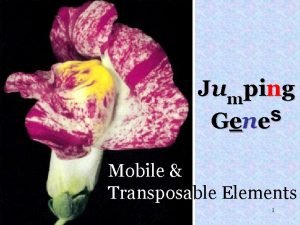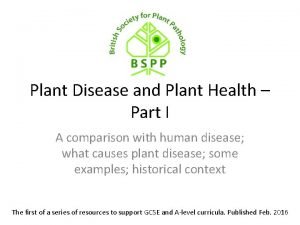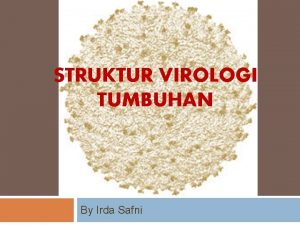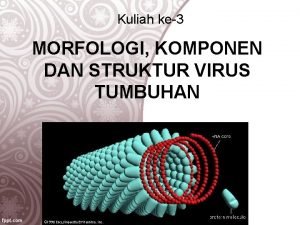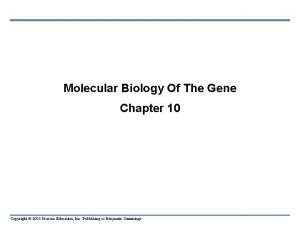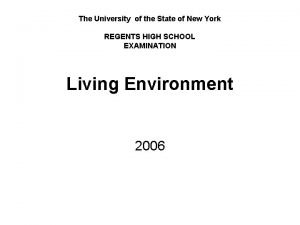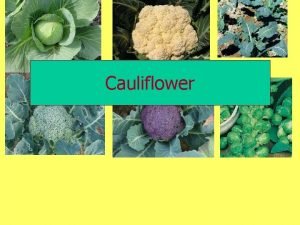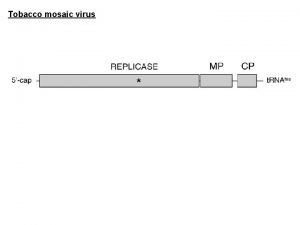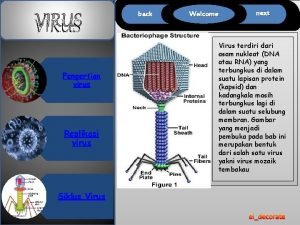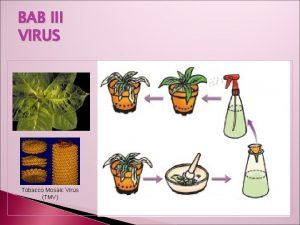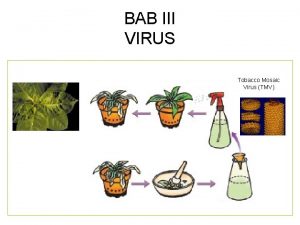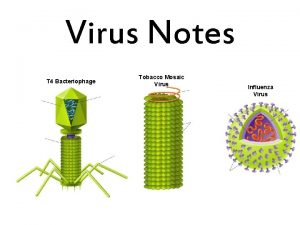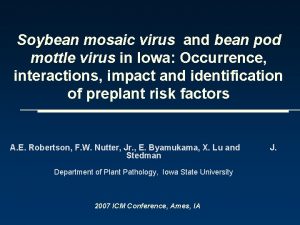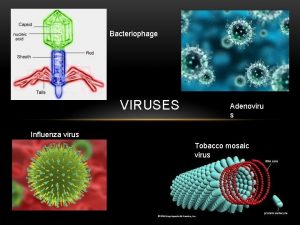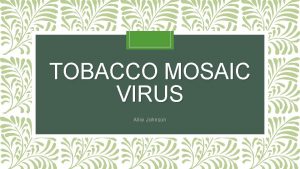Cauliflower Mosaic Virus Plant Viruses Plant viruses are











- Slides: 11

Cauliflower Mosaic Virus

Plant Viruses: Plant viruses are considered as efficient gene transfer agents as they infect the intact plants and amplify the transferred genes through viral genome replication They are non integrative vectors Eg, Pepper mint mottle virus, Leaf curl virus

Criteria needed: �The virus must be capable of spreading from cell to cell through plasmodesmata �The viral genome should be able to replicate in the absence of viral coat protein and spreads from cell to cell �Elicit little or no disease symptoms �Should have broad range of host

Caulimo. Viruses �Caulimoviruses contain circular ds DNA and are spherical in shape �This group includes 15 viruses of which Ca. MV is the most important for gene transfer �The other caulimoviruses includes carnation etched virus, dahlia mosaic virus mirabilis mosaic virus and strawberry vein banding virus


Cauliflower Mosaic Virus �Ca. MV is a plant virus that infects mostly brassicaceae family( cauliflower and turnips) and Solanaceae species �Ca. MV is transmitted in a non circulatory manner by aphid species Mysus �It is a icosahedron structure with a diameter of 52 nm built from 420 cap protein subu nits

Genome of Ca. MV Movement Protein, Insect transmission Factor, Structural Protein, Translational factor, Reverse Transcription, Cap

�Thepromoter of the 35 S RNA is a very strong constitutive promoter responsible for the transcription of the whole Ca. MV genome. � It is well known for its use in plant transformation. � It causes high levels of gene expression in dicot plants �The 35 S RNA is particularly complex, containing a highly structured 600 nucleotide long leader sequence with six to eight short open reading frames �This leader is followed by seven tightly arranged, longer ORFs that encode all the viral proteins. The mechanism of expression of these proteins is unique, in that the ORF VI protein (encoded by the 19 S RNA) controls translation reinitiation of major open reading frames on the polycistronic 35 S RNA, a process that normally only happens on bacterial m. RNAs

Use of Ca. MV in gene transfer �For effective transmission of Ca. MV the foreign DNA must be encapsulated in viral protein and the inserted gene should not interfere with native assembly of virus �Ca. MV does not contain any non coding region wherein foreign DNA can be inserted �But there a are two genes namely gene II and gene VII have no essential functions for the virus �So the gene of interest can be replaced in the place of these two genes �Attractive feature is infection is systemic and the genome has 3 discontinuities

Use of Ca. MV as a vector pertains to the bacterial dhfr (dihydroxy folatereductase) gene inserted in the place of gene II and successfully expressed in plants �This dhfr gene is needed for providing resistance to methotrexate( inhibitor of dhfr and extremely toxic to plants) Limitation of Ca. MV: �Limited capacity for insertion �Infective capacity is lost if few hundreds of nucleotides are introduced �Because of its exceeding natural genome size they are not effectively suitable for gene transfer

 Cauliflower mosaic virus
Cauliflower mosaic virus Insidan region jh
Insidan region jh Youtube . com / watch v = roxnvcaezjs
Youtube . com / watch v = roxnvcaezjs Watch?v=dhlvcdeg0yg
Watch?v=dhlvcdeg0yg Clavibacter
Clavibacter Tobacco mosaic virus
Tobacco mosaic virus Struktur virus tmv
Struktur virus tmv Brome mosaic virus
Brome mosaic virus Hershey and chase experiment
Hershey and chase experiment Cauliflower chaos fractals every
Cauliflower chaos fractals every The diagram below shows how a coverslip should be lowered
The diagram below shows how a coverslip should be lowered Preventive of curds from direct sunlight is known as
Preventive of curds from direct sunlight is known as
